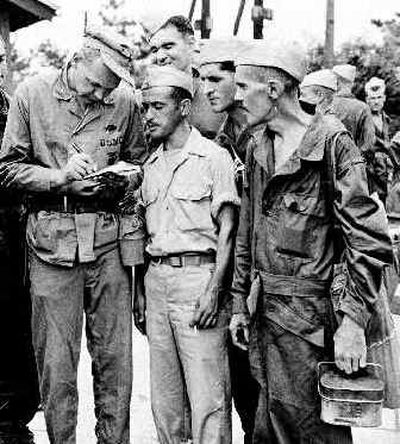WWII soldier’s flag now a memorial

ALTAMONT, N.Y. – A soldier held in Japanese prison camps in World War II secretly painted stars and stripes on pilfered paper hidden from his captors, then held the flag up high to greet American planes flying overhead when his camp was liberated.
After returning home, Cpl. Millard Orsini consigned the object of his secret work to a closet.
In fact, he rarely mentioned the war or the moldering flag, and he died in 1978 from a heart attack.
“He was really a hometown hero who got lost in the cracks,” said Tony Ferraioli, who led the effort to restore the flag.
Its dark red stripes and 48 stars have been restored, and it now hangs in a frame at the Homefront Cafe, a World War II-themed restaurant in Altamont, Orsini’s old home village near Albany.
Orsini was one of seven brothers who served during World War II. The combat engineer was captured by Japanese soldiers early during the war in the Philippines.
In April 1942, he and some 70,000 fellow prisoners were herded into the 55-mile Bataan Death March, during which up to 10,000 marchers died.
The next 39 months in Japanese prison camps were nearly as brutal. A book on the death march, “Horror Trek,” described his punishment in 1944 for stealing potato peels from a trash heap: “(H)e was slugged and beaten by a dozen guards until he collapsed – then he was kicked in the face.”
He painted the flag on a newspaper-size piece of pulpy paper, maybe a window shade or wrapping paper, using stolen or creatively mixed oil paints. The craftsmanship is regarded as meticulous.
It is believed by many that he hid the flag under floorboards while his fellow prisoners kept watch.
“If he got caught, it would have been the end of him,” said his brother, Joseph Orsini.
Joseph Orsini remembers his brother talking about holding the flag up to greet American planes flying over the newly liberated camp.
Ferraioli, who was commander of the Altamont Veterans of Foreign Wars post in 2001, decided to honor Orsini during the post’s annual “Loyalty Day” celebration.
Orsini’s widow handed over her husband’s Purple Heart, Bronze Star and snapshots. She also gave him the folded flag, torn and blackened by mold.
Local residents raised $3,000 for textile restoration. The flag, brightened up, vacuum-sealed and framed, was unveiled at a Loyalty Day ceremony June 2002.
It hung for a while in local government offices, but veterans felt a more fitting place was the restaurant decorated with Norman Rockwell prints and sepia-toned snapshots of soldiers.
It’s not exactly a museum setting, but owner Cindy Pollard keeps a history of the flag handy and is happy to tell the story of its maker. She’ll also show a photo of the seven Orsini brothers in uniform, dated 1947.
What inspired Orsini to risk his life to make the flag is not clear. Those who knew him say that the flag was a simple symbol of his deep patriotism.
A prisoner of a different war, U.S. Sen. John McCain, tells an anecdote about a comrade who sewed a flag inside his shirt so others could pledge allegiance. After the flag was discovered and the prisoner was beaten, he started to make another one.
Pollard sees a similar patriotic spirit in Orsini and makes it a point to tell that to children who come to see the flag.
“I like to tell how much this man loved his country,” Pollard said.